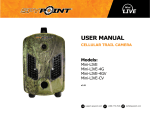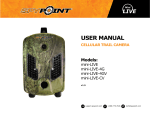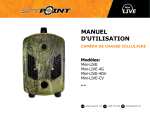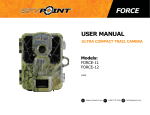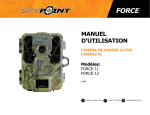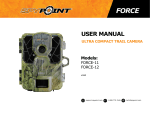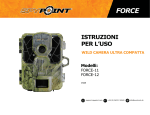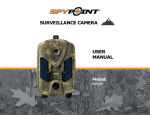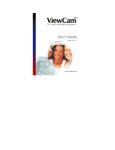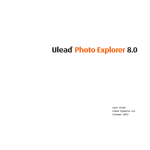Download Medion PHOTO EXPRESS 4.0 User guide
Transcript
version 4.0 User Guide First English edition for Photo Express version 4.0, December 2000 © 2001 Ulead Systems, Inc. All rights reserved. No part of this publication may be reproduced or transmitted in any form or by any means, electronic or mechanical, including photocopying, recording or storing in a retrieval system, or translated into any language in any form without the prior written permission of Ulead Systems, Inc. Software license The software described in this document is furnished under a License Agreement which is included with the product. This Agreement specifies the permitted and prohibited uses of the product. Licenses and trademarks Ulead Systems, Inc., the Ulead logo, Photo Express, and Album are trademarks of Ulead Systems, Inc. PhotoDisc® Copyright 2000, PhotoDisc. PhotoDisc is a trademark of PhotoDisc, Inc. All other product names and any registered and unregistered trademarks mentioned in this manual are used for identification purposes only and remain the exclusive property of their respective owners. Sample files Files provided as samples on the program CD can be used for personal demonstrations, productions and presentations. No rights are granted for commercial reproduction or redistribution of any sample files. Ulead Systems, Inc. 2 North & South America: Ulead Systems, Inc. http://www.ulead.com E-mail: [email protected] International: Ulead Systems, Inc. http://www.ulead.com http://www.asiapac.ulead.com http://www.ulead.com.tw E-mail: [email protected] Europe: Ulead Systems GmbH http://www.ulead.de E-mail: [email protected] Japan: Ulead Systems, Inc. http://www.ulead.co.jp E-mail: [email protected] What's inside Welcome to Photo Express! ......................................................................................................................... 4 What’s new in this version? ........................................................................................................................ 4 Getting started ............................................................................................................................................... 6 Overview ........................................................................................................................................................ 7 Customizing the look ....................................................................................................................................... 9 Ulead Links ....................................................................................................................................................... 9 Browse mode .................................................................................................................................................. 10 Photo mode ..................................................................................................................................................... 11 Project mode ................................................................................................................................................... 11 Preparation ................................................................................................................................................... 12 Getting photos from digital imaging devices ................................................................................................ 12 Batch Adjust .................................................................................................................................................... 13 Editing ........................................................................................................................................................... 14 Selecting the appropriate tool ........................................................................................................................ 14 Using the Selection tools ........................................................................................................................... 19 After the selection process ............................................................................................................................ 21 A few words about objects ............................................................................................................................. 21 Working with Text ....................................................................................................................................... 22 Improving how your text looks ....................................................................................................................... 22 Working with Painting and Cloning tools ................................................................................................. 24 The Effect menu .......................................................................................................................................... 25 Adding decoration ....................................................................................................................................... 27 Beyond Photos ............................................................................................................................................. 30 Working with templates .................................................................................................................................. 30 Customizing a template ................................................................................................................................. 31 Web Studio ..................................................................................................................................................... 32 Calendars and Planners ................................................................................................................................ 36 Wallpaper ....................................................................................................................................................... 37 Planner ............................................................................................................................................................ 37 Printing and Sharing ........................................................................................................... ......................... 38 Printing ............................................................................................................................................................ 38 Saving your work ............................................................................................................................................ 40 Sharing across the Internet .................................................................................................... ....................... 41 Glossary ....................................................................................................................................................... 42 3 Welcome to Photo Express! Welcome to Photo Express, the ultimate tool for creating cool photos and projects that you can share with family and friends. Photo Express is much more than just a simple imageediting program. It’s a fun and exciting way of Expressing your creativity. Transform your ordinary, lackluster pictures into extraordinary, artistic greeting cards, calendars, banners, and even animated Web cards, or Web pages. In this digital age, you need software that is able to get images from a wide variety of devices, easily modifies the images, and offers many different options for distributing them to your nearest and dearest. What’s new in this version? There is a host of new features and tools available for you in this version of Photo Express. Some of these features include: 4 Completely new look and feel Redesigned and improved layout for greater convenience and efficiency. Browse for files and folders, and edit and enhance images all within the Photo Express workspace. That’s not all. There are a number of skins and backgrounds to choose from for customizing the look. Batch Adjust Apply common corrective adjustments to multiple files at once rather than opening each file individually. This can also be used for converting file formats. Animation effects Create stunning animated graphics to put on your Web pages or share via e-mail. You only need to select a preset from Fireworks, Kaleidoscope, or Magic Cube, and Photo Express will do the rest. Magic cube Fireworks Kaleidoscope iMira Maintain your own online photo album with iMira’s free online photo sharing service. After creating your personal account, you will be able to post your photos directly from within Photo Express. Enhanced features and tools A number of features have been improved for better performance, and some new tools have also been added. Enhanced SmartSelect tool. Added printing options. New Signature tool. Added text effects. 5 Getting started To install Photo Express: 1 Place the Photo Express CD into your CD-ROM drive. 2 When the Setup screen appears, follow the instructions to install Photo Express onto your computer. Note: If the Setup screen doesn’t appear after loading the CD, double-click the My Computer icon on your Windows desktop then double-click the icon for the CD-ROM drive. When the CD-ROM window opens, double-click the Setup icon. (Autorun screen is subject to change, depending on your version of Photo Express) After you have installed Photo Express, please take a moment to register online. If Photo Express is open, on the Help menu select Online Registration. Alternatively, you can point your Web browser to the Ulead Web site (http://www.ulead.com). Becoming a registered user entitles you to product updates, free downloads, and technical support should you have any problems with the Photo Express program. When you run Photo Express, make sure your display is set to a resolution of at least 800x600 and either HiColor (15/16 bit) or True Color (24 bit) mode. To run Photo Express: • Double-click the Photo Express icon on your Windows desktop. • Or, select the Photo Express icon from the Ulead Photo Express program group on the Windows Start menu. 6 Remember, if you get really stuck while running Photo Express, you can always use the Help button found on the Shortcut bar. Simply click the button and when your mouse cursor changes, click on the option or tool you don’t understand. Overview Photo Express is a self-contained program, so browsing, editing, and creating are all done from a single screen. Below is a guide to all the main elements of the program window. Browse mode Photo mode Project mode Menu bar Mode menu Open Guide tips Menu Command bar Options panel Shortcut bar Workspace Thumbnail strip Guide tips Global Viewer 7 Menu bar Menu Command bar A number of commands common to Windows applications are found here. Lists all the command categories and tools available for the mode you are currently using. Mode menu Switch among Browse, Photo, and Project modes. Browse mode is where you locate and organize files. Photo mode is where the majority of image-editing and enhancing takes place. Project mode is where you create cards and other items from templates. Shortcut bar Depending on the current mode, command category and tool, various useful commands are made readily accessible. Workspace This is where you actually view and edit your projects. Options panel Displays all the different possibilities and settings available for any given function. Set all tool attributes from this panel. Guide tips Click the lightbulb to open the guide tips for the currently selected function. This walks you through the basics of a function. You can turn them on or off in File: Preferences [F6]. Global Viewer Thumbnail strip Displays all the images you have opened. Double-click an image on the Thumbnail strip to open it in the workspace. 8 Just to the right of the Thumbnail strip, this tool lets you navigate around magnified images that can no longer be displayed entirely on screen. Customizing the look Tired of looking at the same dreary windows all the time? Photo Express now makes it possible to change the workspace background and the skin around the Menu Command bar. Selecting a skin and background: 1 On the Shortcut bar, click Change the appearance of Photo Express. 2 In the dialog box that appears, select from among the preset skins and backgrounds. 3 Click OK. Note: Checking the Ulead Web site for new skins is easy, just select Get Skins on the Ulead Links menu. Using your own image as the background: 1 Select an image in Browse mode. 2 Right-click and select Set As Background on the pop-up menu. Tip: The Modify Photo Express Interface dialog box also has transparency options. Ulead Links Check out the Ulead Web site periodically to keep yourself up-to-date with important program news and promos. The Ulead Links menu offers quick access to a number of useful links related to the program, and displays these Web pages instantly in the Photo Express workspace. 9 Browse mode Browse mode is arranged in a convenient way for locating multimedia files. There is a folder tree in the Options panel, and the selected folder contents are viewed as thumbnails in the workspace. A variety of display options are available on the Shortcut bar and View menu. You can arrange icons, change the thumbnail size, and specify the types of multimedia files to display. An integrated search tool is also available to help you find files easily. Using Browse mode: Locate and select a folder from the folder tree to display the contents in the workspace. Tips: • • • Use the tools on the folder tree toolbar to move quickly between recently browsed folders. Use the tools on the Shortcut bar or on the View menu to change how files are displayed. You can also change the thumbnail size with [+] and [-] keys. Once you’ve located the images to edit, there are four ways to open them to the workspace: • Double-click a thumbnail. • With thumbnails selected, click Open on the Shortcut bar. • Drag selected thumbnails to the Thumbnail strip. • Right-click a selected thumbnail and select Edit on the pop-up menu. 10 Tip: Select multiple images by pressing [Ctrl] or [Shift] while clicking the thumbnails. Photo mode If you’ve already opened images in the workspace, then you’re ready to begin editing and enhancing. In Photo mode, there is a large selection of tools to prepare your images for projects, add special effects, or just make touch-ups. The editing and enhancing tools are all available on the Menu Command bar Edit menu. When you select Edit, a submenu opens to display a list of categories. Select any of the categories to display the available tools. Tip: Quickly access tools that you’ve just closed by clicking List the recently used on the Shortcut bar. tools Project mode Project mode gives you a focused environment in which to create custom greeting cards, name cards, invitations, and much more by providing you with a large range of templates. While in Project mode, you can only open template files, but you can add image files of any type to your templates in order to customize them. Project templates are available on the Menu Command bar Get Project menu. There is a wide variety of categories to choose from. For more information about working with templates, see page 30. 11 Preparation Photo Express is an excellent tool for transferring images from a digital imaging device to your computer simply and efficiently. For this chapter, we will discuss the various means available for making the import process more efficient, as well as introduce you to the Batch Adjust tools for making simple adjustments to multiple images without opening them. Getting photos from digital imaging devices While photos may be imported to your computer from within any mode, for the purpose of showing you all the import options, we’ll work in Browse mode. The process for importing images from any digital imaging device is basically the same. Step 1 Acquiring images: 1 Select Get Photo and then select your device type. Step 2 Step 3 2 In the Options panel, select your device from the list. 3 Enter a File name prefix, which will be appended with a sequential number (ex. Pict001, Pict002, and so on.). 4 Select a File type. 5 Click Acquire. (Import for Video Capture). Step 5 Step 4 Tips: • Apply post-processing Automatically make minor adjustments to the imported files, such as alignment and lighting. • Enable slicing Scan multiple images at once and have them cut into separate files. • Show TWAIN data source Clear this option to scan images without opening the external program (TWAIN). 12 Ulead Video Capture, an integrated component of Photo Express, makes capturing still images a snap. Step 3 Step 1 Using Ulead Video Capture: 1 In the Ulead Video Capture dialog box, click Capture when you see your desired image in the preview window. 2 In the Captured Image preview box, while pressing [Ctrl], select the images you want to import. 3 Click Insert to import the selected images into Photo Express. Step 2 Note: Advanced opens options for changing video camera settings. For more information about the settings, refer to the device manual. Batch Adjust This new feature for Photo Express makes editing multiple images much less time-consuming. You can Enhance, Rotate, and Convert images without opening a single file. Using Batch Adjust: Step 3 Step 2 Step 1 1 In Browse mode, select the images to be modified. 2 Select the type of modification on the Batch Adjust menu. 3 For Enhance and Rotate, click the icons for the adjustments you want to apply. 4 Click Next when you have completed your adjustments. Step 4 5 Select a saving option, then click Save. For Convert: • To specify a particular format for converting, click More file formats. • The Quality level you select will determine the file size. Step 5 13 Editing Photo Express can help you create “the perfect photograph” without having to spend a lot of time or energy trying to understand photographic techniques. Photo Express allows you to correct common photographic errors such as overexposed and unfocused shots. For this chapter, we will discuss: • the various features of the Adjust and Selection tools to give you a better understanding of what’s available for accomplishing specific corrective tasks. • the various types of objects and the features available for working with them. Edit: SmartEnhance Edit: Rotate & Resize Edit: Shape Selecting the appropriate tool Images will often need some adjustments, especially if you’ve retrieved them from a digital camera or scanner. The following tools are available on the Adjust menu. Automatically enhancing your photos: 1 In Photo mode, click Edit on the Menu Command bar then select Adjust: SmartEnhance. 2 In the Options panel, select the tool that you want to use. Photo Express will automatically find the optimal settings for each tool and immediately effect the changes as you click the icons. 14 Original Color Enhancer Rotating and resizing your image: 1 In Photo mode, click Edit on the Menu Command bar then select Adjust: Rotate & Resize. 2 In the Options panel, select a rotating or flipping icon to apply to your image. Resizing height 3 Click Close when done. Notes: • If you want more control on how you rotate your image, use the round, corner control handles on the image. • Resize your image by dragging the small, round control handles on the image. Rotating manually Flipping horizontally Trimming your images: 1 In Photo mode, click Edit on the Menu Command bar then select Adjust: Trim. 2 Select a Trim shape in the Options panel. 3 Reposition the trim shape on the image. 4 Select a Soft edge value for the trim shape. This helps the edges of the trimmed area blend more with the background. 5 Click Apply. Notes: • If you want to create a new image out of the trimmed area, select Create a new image in the Options panel. • You can create your own trim shapes by making a selection and then using the Crop function. See “Using Selections,” on page 19. 15 Resizing your images: 1 In Photo mode, click Edit on the Menu Command bar then select Adjust: Resize. 2 In the Options panel, select a Standard size or enter the custom size you want to resize the image to in User-defined. 3 Click Apply. A 1156x763 image at 200 dpi Notes: • Select Keep aspect ratio to prevent the image from stretching unnaturally. • The image resolution determines how the image prints on paper - lower resolution uses less and larger pixels to generate the image, while higher resolution uses more and finer pixels. A 1156x763 image at 400 dpi Adjusting the focus on an image: 1 In Photo mode, click Edit on the Menu Command bar then select Adjust: Focus. 2 Apply a Focus preset by double-clicking a thumbnail or dragging it to the image. Or, click the Advanced mode button to make your own adjustments. 3 In Advanced mode, adjust the Level and Range sliders. The Preview window at the top of the Options panel will show the effect of the adjustments as you make them. Original 4 After making the adjustments, click Apply. 16 After Adjusting the lighting on an image: 1 In Photo mode, click Edit on the Menu Command bar then select Adjust: Lighting. 2 Apply a Lighting preset by doubleclicking a thumbnail or dragging it to the image. Or, click the Advanced mode button to make your own adjustments. 3 In Advanced mode, adjust the Brightness, Contrast and Gamma. Check the Preview window in the Options panel to see the effect of your adjustments as you make them. Original After 4 After making the adjustments, click Apply. Balancing the colors on an image: 1 In Photo mode, click Edit on the Menu Command bar then select Adjust: Balance Color. 2 Apply a Balance Color preset by doubleclicking a thumbnail or dragging it to the image. Or, click the Advanced mode button to make your own adjustments. Original 3 In Advanced mode, adjust the Cyan to Red, Magenta to Green and Yellow to Blue. Check the Preview window in the Options panel to see the effect of your adjustments as you make them. 4 After making the adjustments, click Apply. After 17 Red Eye tool This tool is most commonly used for removing the red on an eye caused by a camera flash. However, it can also be used for changing eye color. Removing red eye from a photo: Step 1 1 Select a Brush size by clicking one of the circles to define the stroke size when the brush is used on the image. Step 2 Step 5 2 Set the color Similarity as reference for adjusting. Use a higher similarity to replace more of the red eye. 3 Set the Strength of the replacement color over the existing color. 4 Select Remove Red Eye to replace red with black. If you want a totally new eye color, select Change Eye Color and then click on a color square for choosing a new color. Step 3 Step 6 Step 4 5 Brush over the area you want to replace. 6 Click Close when you are satisfied with the result. Tips: • • 18 Click Reset attributes to revert to the default settings. Zoom in on the image by pressing the [+] key. Zoom out with the [-] key. Using the Selection tools At this stage, you should be familiar with the adjustment tools. You’ve probably noticed that some images only require adjustments to certain areas, or perhaps you would rather remove those areas from the image entirely. This is where the selection tools come in handy. With selections, you are able to modify specific parts of an image while leaving the rest intact. In Photo mode, you will find the available selection tools on the Edit: Selection menu. After creating your selection areas, you can convert them into objects by simply dragging them with the mouse. These objects can then be moved, edited, and changed without affecting the rest of the photo. You can also cut and paste them into other images or projects. Selecting an area using a simple shape: 1 In Photo mode, click Edit on the Menu Command bar then select Selection: Shape. Step 2 Step 1 2 In the Options panel, choose a shape. 3 In the workspace, make a selection area by dragging the cursor over the image. 4 Release the mouse button to complete the selection. Note: To create a selection area using a center point as a reference as you move outwards, select Draw from center on the Selection tools options pop-up menu. Step 3 19 Making selections using the SmartSelect tool: Step 1 1 In Photo mode, click Edit on the Menu Command bar then select Selection: SmartSelect. 2 Click at the point where you want to begin the selection area. When the red button appears, click at areas around the image to make new reference points. 3 Click the red button again to close the selection. The button then turns to green. Step 2 Step 3 4 To fine tune the current selection, move the mouse over an area of the selection frame until the cursor changes to a pointing finger. 5 Click and drag to modify the highlighted portion of the selection frame. 6 When done editing, click the green button to create the actual selection. Step 2 Step 1 Tip: When the surrounding colors are very similar to the edge colors, adjust the Tolerance slider to the left. Step 1 Selecting an area by color: 1 In the Menu Command bar, select Edit: Selection - By Color. 2 Click on or drag over the base image to select reference colors. Notes: • 20 • The Similarity value determines the range of colors to include in the selection. Adjust it if you find that your selection is not clean or does not cover the entire range of the selected color. The Expand selection option selects all areas of a similar color throughout the entire image. Step 2 After the selection process Once you have made your selection, there are a number of things that you can do with it. • Use the selection to crop the photo. This means that only the selected area will remain while other parts of the image will be removed. In the Options panel, click Next, and then click Crop with current selection. • Create stunning edge effects. Step 4 Step 3 Using the Edges effect: 1 Click Next to go to the Other Options panel. 2 Select an Edge type on the drop-down menu. 3 Click Show selected edge type presets. 4 Double-click a preset to apply it to the image. 5 Click Close when done. Step 1 Step 5 Step 2 Notes: • • • • Drag the selection to turn it to an object, or straight to the Thumbnail strip for a new image. Maintain the current selection shape even when the Edge preset is of different shape by selecting Keep original shape. Select colors for the edges of the 2D/Mask and Magic effects in Advanced mode. Personalize the Text edge effect by typing in your own words in Advanced mode. A few words about objects Objects are self-contained components placed on images or projects. These can be frames, shadows, text, image, or the background. When saved to a *.UPX (for images) or *.TPX (for projects) format, each object’s characteristics and attributes remain editable for future editing. Below are some useful object information: • Most objects can be adjusted using the tools used to create it. • Adjust an object’s layer by using the Object Level buttons on the Shortcut bar. • Right-click on an object and select Transparency to define how see-thru the object is against a background. • In order to integrate an object into an image permanently, right-click the object and select Merge on the pop-up menu. 21 Working with Text Adding text is a quick and easy way to liven up any photo or to make postcards, greeting cards, invitations, and birthday cards. Photo Express also provides you with an extensive range of cool effects that you can apply to your text to create even more unique and impressive projects. The Text tools are available in Photo or Project mode on the Edit: Text menu. Step 3 Step 1 Step 2 Adding new text: 1 Select Edit: Text - Add/Edit on the Menu Command bar. 2 In the Options panel, enter the text in the Text entry box. 3 Adjust the available options to the desired settings. 4 With the Enter new text option selected, click Apply to add the text to the photo or project. 5 Click Close when you are satisfied with the result. Tip: Resize the text manually by adjusting the text object marquee in the workspace. Step 4 Step 5 Note: Edit the text object in the workspace by double-clicking the text object then in the Options panel make the necessary adjustments and select Update the selected text before clicking Apply. Improving how your text looks Simply adding text to an image is often enough to attract attention, but if you really want the text to get noticed, try flaunting it with some of the incredible effects in Photo Express. Note: Remember that you need to make the text object active first in the workspace (done by simply clicking on it) before you can use any of the Text tools for creating effects. 22 Transforming text objects: Step 2 Step 1 1 Select Edit: Text - Transform on the Menu Command bar. 2 In the Options panel, select a transform tool of your choice. 3 Move your mouse over any of the control handles. As soon as the pointer changes to a four-directional arrow, click and drag in the desired direction. 4 Click Close when done editing. Reshaping text objects: Step 4 Step 3 Step 2 Step 1 1 Select Edit: Text - Reshape on the Menu Command bar. 2 In the Options panel, select a reshape type on the drop-down menu. 3 Apply a preset by double-clicking a thumbnail or dragging it to the image. Step 3 Note: The Text Special F/X is not available in the PhotoExpress SE version. 23 Working with Painting and Cloning tools These tools give you the opportunity to reveal your creative side. Use the Paint tool to add personal touches to your images and use the clone tool to replicate portions of the image to create interesting artworks. The Paint tools are available in Photo mode on the Edit: Paint menu. Step 2 Painting with the Brush tool: Step 3 1 In the Options panel, adjust the necessary attributes. 2 Move your mouse over the image to the position where you want to start painting. 3 Click and hold the mouse button down while dragging. 4 Release the mouse to end the stroke. 5 Paint to your heart’s content. When you are satisfied with the result, click Close. Step 1 Tip: You can press Ctrl + Z to instantly remove the last stroke you made. Step 4 Step 5 Step 1 Using the Clone tool: Step 2 Step 5 1 In the Options panel, click the thumbnail image to clone in the Select source photo thumbnail strip. 2 Click within the Source photo view window to mark a reference point on your source image. 3 Click the Adjust brush attributes icon. Step 3 Step 4 4 Adjust the other settings in the Options panel as desired, then click OK. 5 Paint on the target image in the workspace to start cloning. 24 Tip: Use the Selection tools to isolate areas of an image that you want to paint on. For information on how to use the selection tools, see page 19. The Effect menu Photo Express’ Effect menu offers a variety of enhancement tools and special effects that can spruce up your images. Select from a wide range of tools available under this menu. Let your creativity run wild! Transforming your images into works of art: Colored pencil 1 On the Menu Command bar, click Edit then select Effect: Artist. 2 On the Artist submenu, select an artist style. 3 Select a preset by double-clicking a thumbnail or dragging into the image. Or, click the Advanced mode button to make your own adjustments. 4 In Advanced mode, adjust the available options to the desired settings. 5 After adjusting, click Apply. Tip: Try mixing the various Artist tools on your images. You’ll be amazed by the creative effect you can produce. Spotlight Applying a spotlight to an image: 1 On the Menu Command bar, click Edit then select Effect: Lenses. 2 On the Lenses menu, select Spotlight. 3 Select a preset spotlight effect from the thumbnails, or click the Advanced mode button to make your own adjustments. 4 After you choose a preset or customize settings, click Apply. 25 Adding bubbles to an image: 1 On the Menu Command bar, click Edit then select Particle: Bubble. Bubble 2 Select a Bubble preset and click Apply. Or, click the Advanced mode button to customize the bubbles. 3 In Advanced mode, adjust sliders for the Amount and Size of the bubbles then select a preset Style from the thumbnails. 4 To set colors for your bubbles, click the Adjust bubble button then either choose a color preset from the thumbnails or customize the colors yourself. 5 Click OK to accept the color settings then click Apply. Tip: In Advanced mode, when a star, bubble or firefly is selected, you can edit individual elements. Just click on one, then adjust the options to the desired settings. To deselect the current element, just click elsewhere in the preview window or click the Deselect button. Other cool effects you can apply to your images 26 Adding decoration The Decorate category in both Photo and Project modes gives you access to ornamental effects. These are special, object-based effects such as Frames, Edges, Props, Shadows, and the unique Add Signature tool that you can use to enhance photos and photo objects. Step 1 Adding special edge effects: 1 On the Menu Command bar, select Edit: Decorate - Edges then select the desired type of edge effect to use. 2 In the Options panel, select from the available Preset edges. 3 Apply a preset by double-clicking a thumbnail or dragging it to the image. Step 2 Step 3 Using the Text edge effect: 1 On the Menu Command bar, select Edit: Decorate - Edges - Text. Step 2 Step 3 Step 1 Step 5 2 In the Options panel, select a Preset edge. 3 Select Edge color then select the color you want for your text. 4 Click the Advanced mode icon. 5 Enter the desired text for your text edge effect in their respective fields. 6 Select the font type on the drop-down menu and select the font style for your text edge. 7 Click Apply. Step 4 Step 6 Step 7 Notes: • • Conform the text edge effect to the selection or image shape by selecting Keep original shape. Select Stretch text to edges to span the text to the length of the sides. 27 Step 2 Adding a signature to an image: Step 1 1 On the Menu Command bar, select Edit: Decorate - Signature. 2 Select a Category in the Options panel. 3 Select a Signature preset in the Options panel. 4 Double-click your choice or click Apply. You can also drag it to the workspace. Step 4 Step 3 Creating your own signature: 1 Click the Create a new signature button in the Options panel. Step 3 2 In the New Signature dialog box, create your custom signature. 3 Adjust the necessary settings. 4 Click Save. Note: Clicking Save will add your custom signature to the other thumbnail presets in the Category (in the Options panel) before you clicked the Create a new signature button. Step 1 Adding a frame to an image: Step 4 Step 1 1 On the Menu Command bar, select Edit: Decorate - Frame. 2 Select a frame in the Options panel then click Apply. Step 2 28 Step 2 Step 3 Step 2 Adding props: Step 1 1 On the Menu Command bar, select Edit: Decorate - Props. 2 Select a prop category in the Options panel. The props for that category appear. 3 Select a clip-art image from the thumbnail window. 4 Double-click your choice or click Apply. You can also drag it to the workspace. Tip: You can resize a prop object the using the Edit: Adjust - Rotate & Resize command. Step 4 Step 3 Adding a shadow to an object: Step 2 1 On the Menu Command bar, select Edit: Decorate - Shadow. Step 1 2 Click the Add shadow button. A shadow will appear under the selected object, along with a shadow handle. 3 Drag the shadow handle to adjust the position of the shadow. Step 3 4 Adjust the settings for the shadow’s Color, Transparency, and Soft edge. Tip: To remove the shadow from an object, right-click the object in the workspace, then select the Remove Shadow option on the pop-up menu. Or, click the Remove shadow button in the Options panel for the Shadow effect. You can restore the shadow by clicking the Add shadow button in the Options panel. Step 4 29 Beyond Photos Now that you’ve worked your way from importing your photos through editing and enhancing them, it is time for the next set of tools for designing your project output. Take advantage of scores of ready-made templates for creating animated Web pages, calendars, cards, posters, and much more. Get Project tools Web tools Working with templates Coming up with a good layout for a Web page, greeting card, or letterhead can really be a challenge. Fortunately, Photo Express includes a wide variety of ready-to-use templates so you don’t have to spend a lot of time worrying about the layout. The templates come with customizable features so you can personalize them to suit your needs. Selecting a template: 1 Click the Mode menu and select Project on the drop-down menu. Step 1 2 On the Menu Command bar, select Get Project. The submenu displays the available project template categories. (The folder tree-like structure functions just like Windows Explorer.) 3 Select a subcategory to display its templates in the workspace. 30 4 Double-click a template to open it in the workspace. Step 4 Step 2 Step 3 Customizing a template After selecting the template of your choice, you are now ready to personalize it. A template consists of several elements that can be changed to best suit your project. Here’s an example of how you can personalize your template to surprise your family and loved ones. Personalizing a template: 1 With an open template in the workspace, click a text object to make it active. Click a text placeholder button to open the Add/ Edit Text dialog box in the Options panel. 2 Modify your text and adjust any settings. Step 1 3 Click Apply when done editing. Drag an active text to reposition. 4 Replace an image by clicking on it. Then, click the image placeholder button to change original image (be it the insert picture or the background picture) with your own. 5 On the pop-up menu, select a source for your replacement. Then, in the Options panel, select an image to replace the original one. Tips: • • You may also drag a few of your images into the Thumbnail strip for easy access. When you need an image from there, click and drag it onto a selected image in the workspace for replacement. If your photo needs a little touch-up, select Edit: Adjust. Here, you’ll find tools for rotating your image, and adjusting its lighting and color balance, among others. Step 2 Step 4 Step 5 Step 3 31 Web Studio The Web Studio plug-in gives you the tools to create great-looking Web pages without writing a single line of code. The Web Studio has a large collection of beautiful and ready-made templates for you to choose from and lets you start creating those Web page masterpieces. Web Page offers various templates that allow you to share a single image over the Web. This is a very attractive and convenient way of sharing images with others. Web Page Create the coolest electronic photo albums that you can either send via e-mail or post to a Web site for the whole world to see and enjoy. (Only available in Browse mode.) Web Album Impress and delight your friends by sending them a multimedia Web card, which can include photos, videos, sounds and more! Web Card Web Show provides a fast and convenient way to create your own slide show with your images on a Web page. Place your photos in one of the templates and send them to your friends, save them to a disk, or burn it to a CD. (Only available in Browse mode.) 32 Web Show Your Web projects The Web Studio functions are meant to be configured by working through the Options panel. Navigate through the various panels using the Next and Back arrow buttons at the bottom of the Options panel. Step 2 Choosing the layout: Step 1 1 Click the Template drop-down menu box to open a list of categories. Select the category to display in the Options panel. 2 Select a thumbnail to display it in the workspace. 3 Click Next. Step 3 Adding personalized titles and image information: Step 4 Step 5 Note: This panel is bypassed for Web Card. 4 Enter your own title text in the Title entry box. 5 Click the Description type drop-down menu and select User defined to enter your own caption. Step 6 6 Click Next. Note: For Web Album and Web Show, if there’s more than one image selected, selecting User defined for Description type requires the addition of an extra panel after clicking Next. This allows you to write a description for each of your images. For Web Album and Web Show (only when more than one image is selected), clicking Photo order opens a dialog box where you can rearrange the display order of your images. 33 Adding extra decorations: 7 All the features available on this panel can be added by clicking the respective icons. • Signature is usually used for adding contact information such as your name or e-mail address. Step 7 • Background music is automatically set to play while your project is being viewed. Use this tool to change or remove the music file. For Web Show only - Set the Play mode of the Web show. You can set a time duration for each image to be displayed or set it to manual mode where buttons will be available for you to navigate through the images. For Web Card only - Many of the elements contained in the pre-designed Web Card and any of the elements you add to it can be modified after selecting them in the workspace. Tip: For Web Cards, link text and image objects to Web sites or to your own e-mail address. Select first the text or image object then select Add URL or e-mail link in the Options panel, then type in the URL or e-mail address. Sharing your project: 8 Select the kind of output you want for your Web project. • CD, available for Web Album and Web Show, creates files necessary for making a CD that plays automatically when inserted in the CD-ROM drive. 34 Step 8 • Post to Web lets you upload your Web projects to an account you’ve established at any of the Web services listed on the drop-down menu. Tips: • • To create an account, select a Web service then click Create an account first to open the registration page of the selected service. To view records of files uploaded to the Web service, select Ulead Links: Web Posting History. There is an option for sending e-mail with a link to the posted pages. Animated Graphics The new animation functions create lively graphics for you to save to a disk or place on a Web page before posting to the Web or sending by e-mail. 1 With images selected, select one of the animation functions on the Web menu. Step 2 Step 1 Step 3 Step 4 2 In the Options panel, select a preset to apply it to the image in the workspace. 3 Click the Play the animation preview button on the Shortcut bar. Click the Stop button on the resulting Shortcut bar when satisfied with the result before clicking Next. 4 Click GIF animation file to save the file to disk or Output to Web page where you’ll go through easy steps of creating Web pages. Step 3 Tips: • • • Only the first frame of the animation will be displayed. Up to six (6) images can be used for creating a single Magic Cube animation file. When saving as a GIF animation file, you can increase the number of frames to create smoother animations, but remember that this will result to larger file size. 35 Calendars and Planners The Calendar is available on the Share menu in all modes. This function is arranged to be configured by working through four (4) Options panels. Navigate through the various panels using the Next and Back arrow buttons at the bottom of the Options panel. Creating a calendar: 1 With an image (in Photo mode) or a template (in Project mode) open in the workspace, select Share and then select Calendar. (Select multiple images in Browse mode to save time in applying the same calendar settings to several images.) 2 In the Options panel, set the Calendar template by selecting the Calendar type and Orientation, then click a thumbnail of your desired style. Step 2 Step 1 Step 3 3 Click Next. 4 Set the start date by the year, month or week, and click Next. Note: The available fields that you can adjust will depend on the Calendar type selected. Step 4 Step 5 5 Click the icons of template elements to add or modify. Note: The Modify selected element option reflects which element is currently active for editing. 6 Click Next. 7 Choose an appropriate method of sharing your work with friends and family. Step 6 Step 7 Notes: • Wallpaper option can set the calendar as your Windows Desktop wallpaper. 36 • Ulead Calendar Checker will automatically update it for you. Use Organize templates to store your current calendar project as template for future use. Tip: To quickly access a variety of useful commands, right-click an object. Planner There is an additional feature, Planner, that may be accessed on the Shortcut bar at any time while using the Calendar function. Step 4 Using the Planner: 1 Click the Planner button on the Shortcut bar. The Planner dialog box opens. Step 1 Step 2 2 Click a day to open the menu of planning options, then enter the necessary information for the selected options. 3 Add a pop-up reminder with or without sound that can be set to display at any time. The reminder need not be set to the same day as the note or the holiday. Step 3 Step 5 4 Change the text color for notes and holidays. 5 Spice up your planner by adding clip art to mark special days. Wallpaper Set your favorite images to be displayed as your desktop wallpaper. Changing your desktop wallpaper: Step 2 Step 1 1 In Photo or Project mode with an image open in the workspace or in Browse mode with an image selected on the Menu Command bar, select Share: Wallpaper. 2 Select the display format in the Options panel. 3 Click Apply to set the desktop wallpaper. 4 Click Close to exit the function. Step 3 Step 4 37 Printing and Sharing Once you’ve put the finishing touches onto your photos, Photo Express provides just what you need to share them with your friends and loved ones. For this final chapter, you will learn about the numerous printing options as well as ways for sharing your work across the Internet. Print tools Share tools Printing Create posters, name cards, stickers, T-shirts, and many other fun projects. All of the printing options available (except Multiple) in Photo Express follow a basic procedure. Basic printing steps: Step 2 Step 3 Step 1 1 In Browse mode, select an image or images. On the Menu Command bar, select Print and then select the appropriate printing function. 2 In the Options panel, make sure that the correct printer is selected. If you need to change any printer settings, open the Printer Properties dialog box. 3 Select a Paper Size and Layout. 4 Select the number of copies. 5 Click Print. Step 4 Step 5 Notes: • • 38 • • When multiple images are selected and they don’t fit in one page, use the arrow keys on the Shortcut bar to navigate through the images/pages. Adjust the printable area by clicking the Modify Printable Area button on the Shortcut bar to precisely adjust the position of the image within the page. In Photo mode, you can only print the currently opened image in the workspace. The Thumbnails and CD cover print options are only available in Browse mode. Multiple The Multiple print option is different from the other options available on the Print menu and therefore, follows a procedure all its own. Step 2 Printing several images on a page: Step 1 1 Select the images that you want to print, and then select Print: Multiple. 2 Select the type of layout you want to use for your images, then click Next. Note: You can still rearrange and further resize or realign images in the layout. Click the specific image frame to make it active for adjustments. 3 Add or replace images in the layout by dragging desired thumbnails over the image frame you want to place your image. Click Next. 4 Set the number of copies to print, then click Print. Note: You can also use the images in the Thumbnail strip to replace the images in the layout. Step 3 Step 4 Other printing choices 39 Saving your work It is a good habit to save your work periodically to ensure that you don’t have to redo everything when unexpected events happen. Keep in mind that saving a project in a *.TPX (*.UPX for image files) format means that you will be able to edit the individual objects when you reopen the file. Saving a photo or project: 1 On the Menu Command bar, select Share: Save. 2 In the Options panel, enter a saving location and file name. 3 Select a File type on the drop-down menu. 4 Click Save. Notes: • Data type describes how much color information is saved with the image. The more color information included in the file, the larger the file tends to be. The highest color data type is True Color. Indexed-256 and Grayscale each contains up to a maximum of 256 distinct colors and are generally quite small. (48-bit True Color and 16-bit Grayscale are supported in TIF format.) • Possible File types for saving are: BMP and TIF can keep the highest level of quality; JPEG is ideal for photos to be used on the Web or sent via e-mail because the file size can be significantly reduced down to the minimum relative to your acceptable quality; UPX for saving photos with unmerged, free-floating objects. These objects can be used again when the file is reopened in Photo Express. 40 Sharing across the Internet Photo Express offers a number of different ways that you can share your images with your friends and family across the Internet. E-mail Photo Express is integrated with popular e-mail applications such as Microsoft Outlook, Microsoft Outlook Express, Netscape Messenger, and Qualcomm Eudora, among others. Sending via e-mail: Step 2 Step 3 Step 1 Step 5 1 On the Menu Command bar, select Share: E-mail. 2 In the Options panel, select Send as an HTML e-mail (to display the images within the body of the e-mail message) or simply as a file attachment. 3 Adjust the Image Dimension and Quality of the image (not applicable for GIF animation, audio, and video files). This will affect the file size. 4 Click Send to open the Send Mail dialog box, then enter the necessary information. Step 4 Note: Selecting the Send separate mails option creates individual e-mails for each image to a single recipient. This is recommended when sending several images for faster download. 5 Click Send. Post to iMira Step 1 Display your photos in your own free online gallery. Uploading to iMira: 1 In any mode, select Share: Upload to iMira on the Menu Command bar. 2 If you have already registered for an account at iMira, enter your user information in the spaces provided in the Options panel then click Upload. Step 2 41 Glossary Advanced mode Global viewer Contains options of a selected tool or effect that you can modify with great precision. The window to the right of the Thumbnail strip that can be used to quickly move around a magnified image that cannot be displayed entirely on-screen. Batch Adjust menu Contains tools that can be used to modify multiple images at once. Gradient Brush HTML Allows you to apply “electronic paint” to images. HTML is the dominant language for publishing hypertext on the World Wide Web. HTML uses tags like <h1> and </h1> to structure text into headings, paragraphs, lists, hypertext links and more. It is the code behind your Web page. Browse mode This is where you can quickly locate and organize your multimedia files. Clip art Ready-made, resizable illustrations which may be cut and pasted or inserted as artwork. Clone Copies or duplicates areas of an image onto the same image or onto another. A gradual transition between two or more colors. iMira Free online photo sharing service, where you can create and manage your own photo albums to share with friends and family. Marquee Frame outlining or surrounding an object or selection. Selection marquees are dashed lines. Object marquees are solid lines. Decorate menu Contains tools and effects that can add creative touches, like frames or shadows, to simple images. Magic texture Contains random color patterns that you can use to create a background or to fill an object or selection. Edges A special effect that lets you add torn paper edges or other interesting borders to a picture. Effect menu This is located at the top of the program UI and contains all of the available tools you can use to enhance your images. Contains tools that you can use to enhance, adjust, correct, or otherwise creatively modify your pictures. Object Fill The process of applying or dumping color into a region or area. 42 Menu Command bar Frame An effect that lets you put a picture frame or border around your images. This is an identifiable component that is selfcontained or simply a “thing” in a Photo Express project. Examples of some objects are: frames, shadows, text, and background objects. Each has its own characteristics and attributes. Options panel This is located at the left side of the Photo Express program UI and is where you can customize the tools and effects. Photo mode Soft edge This is where most image editing and enhancing is performed. This is used to blend the edges of an object with the background. The higher the value the more the edges blend in. Placeholder A button that appears on an active element within a project template, indicating that the element may be modified or replaced. Click the button to view the available options. Templates Templates are project designs that can easily be customized with your images and text. They can help you get started quickly on a new project. You can create and save your own templates for future use. Preset mode Contains samples using the selected tool with varying degrees of predefined settings. You can quickly enhance your image by simply dragging or doubleclicking a sample thumbnail. Project mode This mode contains fun projects and useful templates for creative expression. Thumbnail A small, low resolution representation of an image. Thumbnail strip A small strip located at the bottom of your screen. This holds all the images and projects that you have open. Here, you can click once on a thumbnail to see a larger preview of it and click twice to open it into the workspace. Props These are clip art type objects that you can add to your projects that will make them more interesting and fun. Transparency Specifies the visibility of one object or image over another. It affects how much you can see through an object or the intensity of an applied effect. Selection Selections and selection tools are used to create areas of an image that can be modified independently of the rest of an image. Selections can be drawn by hand, or chosen by color or shape. Selection areas can be converted to objects. Share menu Contains tools for outputting your photos or projects. You can save or send them to friends via e-mail, post them to a free photo sharing service, or create Windows desktop calendars or wallpaper. Ulead Links menu Provides you with quick access to several useful Photo Express related Web sites. User interface (UI) The parts of the program which can be seen and the commands and mechanisms used to control its operation. Wallpaper The color or image that is used as the background for the Windows desktop. Shortcut bar This toolbar, located at the top of the Photo Express workspace, contains commonly used commands for easy access. Skins Customizable component of the UI that allows you to change its appearance. Web Studio The collection of tools and functions available from the Web menu, which can be used to create various Web related projects including, Web pages, cards, albums, shows, and animated graphics. 43











































